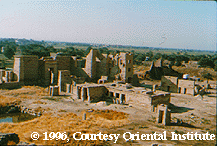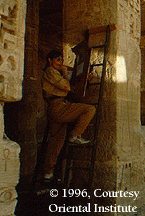 The University of Chicago Magazine April 1996
The University of Chicago Magazine April 1996


 Hallowed ground: The Temple of Amun was considered not only the sacred home of the chief god, Amun, but the burial spot of eight Egyptian gods of creation. Survey artist Tia di Cerbo checks the accuracy of her drawing against an original carving.
Hallowed ground: The Temple of Amun was considered not only the sacred home of the chief god, Amun, but the burial spot of eight Egyptian gods of creation. Survey artist Tia di Cerbo checks the accuracy of her drawing against an original carving.What was one of ancient Egypt's most sacred temples now stands on the brink of ruin. A thick coat of dust, soot, and bird droppings obscures the once brightly-colored sandstone walls, within which high priests conducted ceremonies in honor of their king of gods, Amun.
Now--thanks to a $455,000 grant from the Egyptian Antiquities Society--University archeologists should be able to restore the temple to some of its former glory while obtaining invaluable archeological data on more than 17 centuries of Egyptian history.
Located in a complex of ancient ruins in Luxor on the Nile River's west bank, the temple was founded in 1,500 B.C. by the ruler Hatshepsut, who attained unprecedented power for a queen, adopting the full title and regalia of a pharaoh. The temple was expanded by succeeding pharaohs and conquering Greek and Roman kings, then fell into disrepair around the second century A.D.
The five-year restoration project will be overseen by Chicago House, the permanent field base in Egypt for the University's Oriental Institute.
The most immediate challenge will be restabilizing the temple's stone foundations. Over the last century, the structure's foundation blocks have sunk, causing several walls to become unstable and cracking some of the temple's decorated sandstone wall blocks.
The project's second main initiative is to painstakingly clean the dirt away from soft sandstone carvings and centuries-old paint--work that will better reveal the many drawings and inscriptions that Chicago House director and associate professor Peter Dorman, PhD'85, describes as "a vast untapped resource of historical, artistic, and religious information."
The restoration will also make more legible what can only be described as graffiti: informal inscriptions left by visitors, including their names and occupations, prayers to the gods and pharaohs--even drawings of themselves. All of this information will be carefully documented in facsimile copies by the project's archeologists, photographers, and specially trained artists.
Those experts will also be busy continuing similar work at the Luxor Temple, on the east bank of the Nile. The Egyptian Antiquities Project provided an extra $135,000 to move forward on stabilization of that temple's sandstone blocks, decorated from the time of King Tutankhamen and now badly eroded by salty groundwater.
As at Amun, the Oriental Institute's specialists are documenting Luxor's many carvings and in-scriptions. The first folio volume of reliefs from the temple appeared last year, and several other volumes are in preparation, revealing stories from the past that now, it would appear, have a very bright future.
O.I. galleries close for renovations
The Oriental Institute Museum's Assyrian, Mesopotamian, and Special Exhibits
halls were shut down in March as the last step in the gradual closure of all
five of the museum's galleries. The Suq gift and book shop, however, will stay
open throughout the renovation project. Expected to be completed in 1998, the
renovation includes construction of a new storage wing and the installation of
climate-control equipment.
Portions of the museum's collections, including objects rarely exhibited, will be displayed at the Smart Museum starting this fall.
Photographs from campus:
Plus items For the Record.